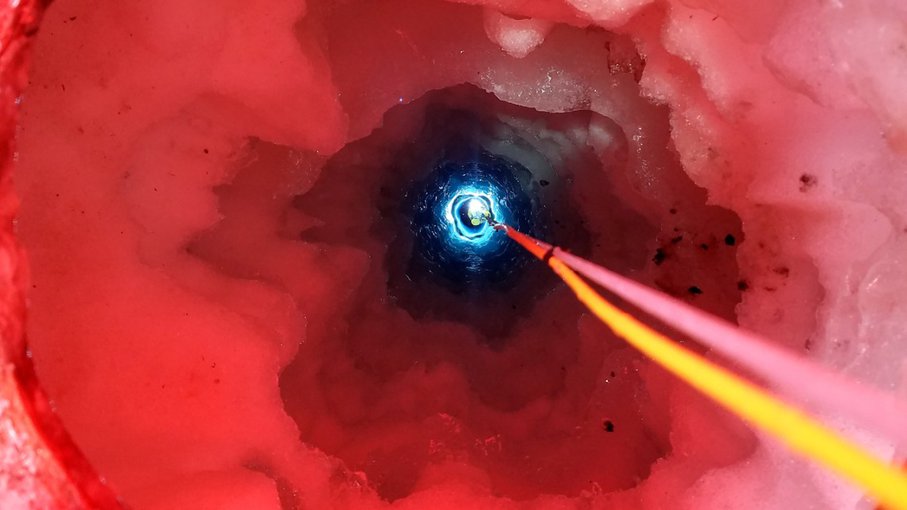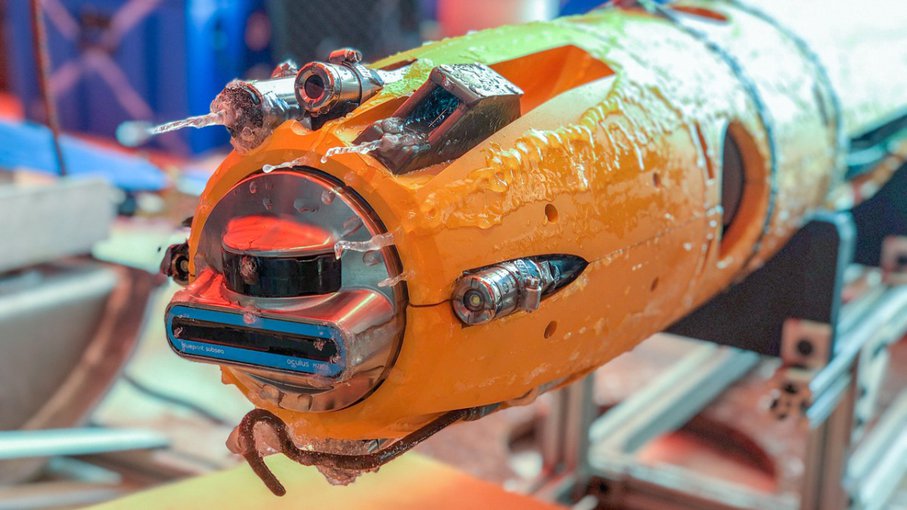
March 8, 2023
Research Highlight
Icefin Dives Below the Antarctic Ice Shelf

The remotely operated underwater vehicle Icefin is visible as it is lowered via a 4.3-mm fiber-optic tether through a borehole to start one of three dives beneath the Ross Ice Shelf. A tent shelter’s color is reflected in the ice.Image credit: Icefin/NASA PSTAR RISE UP/Schmidt/Quartini.
In 2019, a group of NASA-supported scientists joined two large, international research expeditions in Antarctica to study the underside of two glacier systems. An expedition to Kamb Ice Stream expedition was led by Antarctica New Zealand, and the US team was supported by NASA’s Astrobiology program. A second expedition to Thwaites Glacier was part of a collaboration between the U.S.’s National Science Foundation (NSF) and the U.K.’s Natural Environment Research Council (NERC) to collect data critical to understanding global climate systems on Earth.
NASA-supported scientists contributed a remotely operated vehicle dubbed Icefin, which was deployed to gather first-of-their kind images and data from beneath both glaciers. Kamb Ice Stream is a cold system experiencing little change, but processes beneath the ice are great analogs for processes on Ocean Worlds. Thwaites Glacier on the other hand is one of the continent’s fastest changing glaciers and also one of the most vulnerable to a changing climate. Thwaites Glacier is warming and has been steadily retreating over the sea floor for more than a decade, while Kamb Ice Stream is presently not moving.

The remotely operated Icefin underwater robot after completing a dive below the Ross Ice Shelf near Kamb Ice Stream in 2019.Image credit: Icefin/NASA PSTAR RISE UP/Schmidt/Lawrence.
The US scientists lowered Icefin through holes in the ice nearly 2000 feet deep, providing a new way of observing these glaciers from below. The data gathered by Icefin is showing researchers how the ice, ocean and seafloor interact, including how much melting is occurring and where. Some of the most exciting results showcased the importance of cracks in the base of the ice, called basal crevasses. At Kamb, the team found that in the cold ocean, melting at the bottom of a crevasse was balanced by refreezing at the top, producing an ice formed from the ocean water called marine ice. This ice captures a trace of the ocean chemistry in it, which could be important for future studies of other planets. At Thwaites Glacier, the warm ocean there was instead driving rapid melting, widening crevasses and contributing to the breakup of the glacier.
These studies highlight how NASA Astrobiology support for research and technology development can have wider applications beyond NASA missions, benefitting research at other agencies and institutions, and making critical observations of the Earth. NASA supported the development of the Icefin underwater robot by PI Britney Schmidt and her team through the Planetary Science and Technology from Analog Research (PSTAR) program.
Results from the study have been published in a series of papers from the team. The results from Kamb Ice Stream, “Crevasse Refreezing and Signatures of Retreat Observed at Kamb Ice Stream Grounding Zone,” were published in the journal Nature Geoscience. The results from Thwaites Glacier are described in the paper “Suppressed basal melting in the eastern Thwaites Glacier grounding zone” published in the journal Nature, and a companion paper “Heterogeneous melting near the Thwaites Glacier grounding line” in the same issue.
Press releases about the study:
Underwater robot helps explain Antarctic glacier’s retreat (Cornell University)
Robot provides unprecedented views below Antarctic ice shelf (Cornell University)
Glimpse beneath iconic glacier reveals how it’s adding to sea-level rise (Nature)
Related:
Life in the Extreme: Surviving Beneath a Glacier, Part II